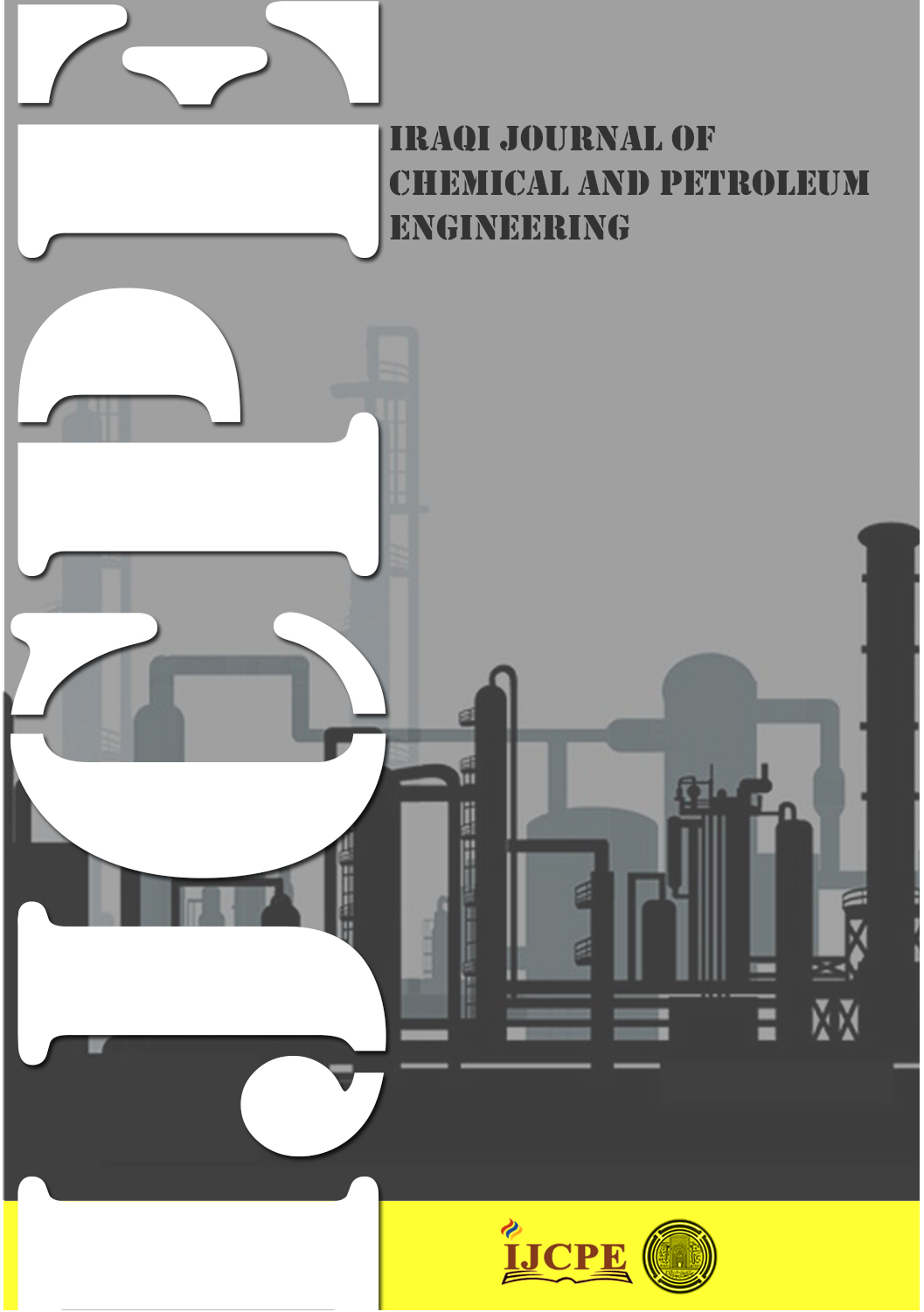Determination of petrophysical properties of Sadi Formation in Halfaya oil field, southern Iraq
DOI:
https://doi.org/10.31699/IJCPE.2025.1.11Keywords:
Sadi Formation; Halfaya Oil Field; Petrophysical PropertiesAbstract
This study aimed to evaluate the reservoir petrophysical properties (porosity, water saturation, and permeability) for optimal flow unit assessment within the Sadi Formation. Utilizing open hole logging data from five wells, the Sadi formation was divided into two rock units. The upper unit (A) is 45-50 meters thick, mainly consisting of limestone, mainly consisting of shaly limestone at the lower part. The lower unit (B) has a thickness of approximately 75-80 meters and is primarily composed of limestone, further subdivided into three subunits (B1, B2, B3). The average water resistivity is 0.04 ohm-m, and the average mud filtrate resistivity is 0.06 ohm-m. The Pickett plot was utilized to determine Archie parameters (tortuosity factor=1, cementation factor= 2, saturation exponent = 1.94). Petrophysical properties were determined through a sequence of operations involving lithology identification, shale volume estimation, porosity calculation, water saturation calculation, and permeability estimation. Lithology was identified using neutron, density and sonic logs with (N-D, M-N) cross plots, which show that the Sadi Formation is mainly limestone. The Gamma ray log was employed to estimate the shale volume of the Sadi Formation using the Larionov equation of old rock, resulting in a shale volume of 7%-58%. After calculating porosity using neutron-density logs, the resulting porosity matched the core porosity. Archie equation was used to calculate the formation’s water saturation, with water saturation less than 0.48 (cut-off) obtained in B1, B2 and B3 units. Finally, the formation permeability was estimated using the Flow Zone Indicator method, which provided a good match with core permeability. Porosity and water saturation were estimated with depth using Techlog software. The best hydrocarbon-holding unit is B2, which has the highest porosity, lowest water saturation, and the best permeability, with a thickness of 20.1 meters. As a result of this study, core plug analysis and well logging data identified eight distinct units in the Sadi Formation. There are three flow sub-units in upper Sadi (B1), three flow sub-units in Sadi (B2) and two sub-units in Sadi (B3). Additionally, it has been found that the marl rock unit (A2) separates the water-bearing zone (A1) from the oil-bearing zone (B).
Received on 06/06/2024
Received in Revised Form on 23/07/2024
Accepted on 30/07/2024
Published on 30/03/2025
References
[1] G. B. Asquith, D. Krygowski, and C. R. Gibson, Basic well log analysis, 2nd Edition: AAPG Methods in Exploration Series 16. Oklahoma: American Association of Petroleum Geologists Tulsa, 2004, pp. 244.
[2] T. Ahmed, Working guide to reservoir rock properties and fluid flow, 1st ed. USA: Gulf Professional Publishing, 2009, pp. 261.
[3] R. M. Idan, A. L. Salih, O. N. Al-Khazraji, and M. H. Khudhair, “Depositional environments, facies distribution, and porosity analysis of Yamama Formation in majnoon oilfield. Sequence stratigraphic approach,” The Iraqi Geological Journal., pp. 38–52, 2020, https://doi.org/10.46717/igj.53.1D.4Rw-2020-05-03
[4] H. Liu, Principles and Applications of Well Logging, 1st ed. in Springer Mineralogy. Berlin, Heidelberg: Springer Berlin Heidelberg, 2017, https://doi.org/10.1007/978-3-662-53383-3
[5] A. Poupon and R. Gaymard, “The evaluation of clay content from logs,” in SPWLA Annual Logging Symposium, SPWLA, 1970, pp. 546–547.
[6] R. J. Jenkins, “Accuracy of porosity determinations,” The Log Analyst, vol. 7, Mar. 1996.
[7] S. Cannon, Petrophysics: a practical guide, 1st ed. UK: John Wiley & Sons, 2015, https://doi.org/10.1002/9781119117636.ch10
[8] U. Ahmed, S. F. Crary, and G. R. Coates, “Permeability estimation: the various sources and their interrelationships,” Journal of Petroleum Technology, vol. 43, pp. 578–587, May 1991, https://doi.org/10.2118/19604-PA
[9] J. O. Amaefule, M. Altunbay, D. Tiab, D. G. Kersey, and D. K. Keelan, “Enhanced reservoir description: using core and log data to identify hydraulic (flow) units and predict permeability in uncored intervals/wells,” in SPE Annual Technical Conference and Exhibition, SPE, Oct. 1993, pp. 205–220, https://doi.org/10.2118/26436-MS
[10] R. A. Hashim and G. M. Farman, “Evaluating Petrophysical Properties of Sa’di Reservoir in Halfaya Oil Field,” The Iraqi Geological Journal, vol. 56, pp. 118–126, Oct. 2023, https://doi.org/10.46717/igj.56.2D.9ms-2023-10-15
[11] B. A. Al-Baldawi, “Evaluation of petrophysical properties using well logs of yamama Formation in abu amood oil field, southern Iraq,” The Iraqi Geological Journal, vol. 54, pp. 67–77, May 2021, https://doi.org/10.46717/igj.54.1E.6Ms-2021-05-27
[12] J. Dewan, Essentials of modern open-hole log interpretation. USA: PennWell Books, Tulsa, 1983.
[13] U. Alameedy, G. M. Farman, and H. Al-Tamemi, “Mineral Inversion Approach to Improve Ahdeb Oil Field’s Mineral Classification,” The Iraqi Geological Journal, vol. 56, pp. 102–113, Aug. 2023, https://doi.org/10.46717/igj.56.2B.8ms-2023-8-17
[14] R. A. Hashim and G. M. Farman, “How to Estimate the Major Petrophysical Properties: A Review,” Iraqi Journal of Oil & Gas Research, vol. 3, pp. 43–58, Apr. 2023, https://doi.org/10.55699/ijogr.2023.0301.1037
[15] A. H. Tali and G. M. Farman, “Use conventional and statistical methods for porosity estimating in carbonate reservoir in southern iraq, case study,” The Iraqi Geological Journal, vol. 54, pp. 30–38, Oct. 2021. https://doi.org/10.46717/igj.54.2D.3Ms-2021-10-22
[16] A. Buono, S. Fullmer, K. Luck, K. Peterson, H. king, and P. J. More, “Quantitative digital petrography: full thin section quantification of pore space and grains,” in SPE Middle East Oil and Gas Show and Conference, SPE, Mar. 2019. https://doi.org/10.2118/194899-MS
[17] V. Krutko, B. Belozerov, S. Budennyy, E. Sadikhov, and O. Kuzmina, “A new approach to clastic rocks pore-scale topology reconstruction based on automatic thin-section images and CT scans analysis,” in SPE Annual Technical Conference and Exhibition, SPE, Oct. 2019. https://doi.org/10.2118/196183-MS
[18] M. Abedini, M. Ziaii, and J. Ghiasi-Freez, “The application of Committee machine with particle swarm optimization to the assessment of permeability based on thin section image analysis,” International Journal of Mining and Geo-Engineering, vol. 52, pp. 177–185, Dec. 2018.
[19] Y. J. Tawfeeq and J. A. Al-Sudani, “Digital rock samples porosity analysis by OTSU thresholding technique using MATLAB,” Iraqi Journal of Chemical and Petroleum Engineering, vol. 21, pp. 57–66, Sep. 2020. https://doi.org/10.31699/IJCPE.2020.3.8
[20] J. Ghiasi-Freez, I. Soleimanpour, A. Kadkhodaie-Ilkhchi, M. Ziaii, M. Sedighi, and A. Hatampour, “Semi-automated porosity identification from thin section images using image analysis and intelligent discriminant classifiers,” Computers & geosciences, vol. 45, pp. 36–45, Aug. 2012. https://doi.org/10.1016/j.cageo.2012.03.006
[21] G. L. Bowers and T. J. Katsube, “Chapter 5: The Role of Shale Pore Structure on the Sensitivity of Wire-Line Logs to Overpressure,” in Pressure Regimes in Sedimentary Basins and Their Prediction, The American Association of Petroleum Geologists, 2001, pp. 43–60. https://doi.org/10.1306/M76870C5
[22] S.-L. Kung, C. Lewis, and J.-C. Wu, “A technique for improving pseudo-synthetic seismograms generated from neutron logs in gas-saturated clastic rocks,” Journal of Geophysics and Engineering, vol. 10, p. 035015, Jun. 2013. https://doi.org/10.1088/1742-2132/10/3/035015
[23] I. Taggart, “Effective versus Total Porosity Based Geostatistical Models: Implications for Upscaling and Flow Simulation,” Transport in Porous Media, vol. 46, pp. 251–268, Feb. 2002. https://doi.org/10.1023/A:1015052712760
[24] M. A. Zainab, I. A. Almallah, and F. M. Al-Najm, “Petrophysical properties evaluation using well logging of the upper sand member of Zubair Formation in Zubair oil Field, Southern Iraq.,” Basrah Journal of Science, vol. 37, pp. 456–480, 2019.
[25] Z. A. Mahdi and G. M. Farman, “Estimation of Petrophysical Properties for the Zubair Reservoir In Abu-Amood Oil Field,” The Iraqi Geological Journal, vol. 56, pp. 32–39, Feb. 2023. https://doi.org/10.46717/igj.56.1B.3ms-2023-2-11
[26] L. I. Schlumberger, “Principles and Application: Schlumberger Wireline and Testing,” Houst. Tex., pp. 21–89, 1989.
[27] M. Nabih, A. Ghoneimi, A. Essa, and A. H. Saleh, “A new vision for hydrocarbon trapping of Alam El-Bueib Formation in Aman oil field using Fault seal analysis technique, northern Western Desert, Egypt.,” Journal of Petroleum and Mining Engineering, vol. 24, pp. 53–66, Mar. 2023. https://doi.org/10.21608/JPME.2023.191475.1152
[28] J. A. Al-Sudani, H. K. Mustafa, D. F. Al-Sudani, and H. Falih, “Analytical water saturation model using capacitance-resistance simulation: clean and shaly formations,” Journal of Natural Gas Science and Engineering, vol. 82, p. 103325, Oct. 2020. https://doi.org/10.1016/j.jngse.2020.103325
[29] W. H. Fertl, “Advances in well logging, well interpretation,” Oil & gas journal, vol. 82, pp. 85–91, 1984.
[30] S. S. Zughar, A. A. Ramadhan, and A. K. Jaber, “Petrophysical Properties of an Iraqi Carbonate Reservoir Using Well Log Evaluation,” Iraqi Journal of Chemical and Petroleum Engineering, vol. 21, pp. 53–59, Mar. 2020. https://doi.org/10.31699/IJCPE.2020.1.8
[31] Z. Riazi, “Application of integrated rock typing and flow units identification methods for an Iranian carbonate reservoir,” Journal of petroleum science and engineering, vol. 160, pp. 483–497, Jan. 2018. https://doi.org/10.1016/j.petrol.2017.10.025
[32] O. Serra, The Acquisition of Logging Data: Part A, 1st ed. USA: Elsevier, 1984.
[33] H. Y. Ali, G. M. Farman, and M. H. Hafiz, “Study of petrophysical properties of the Yamama Formation in Siba Oilfield,” The Iraqi Geological Journal, pp. 39–47, Sep. 2021. https://doi.org/10.46717/igj.54.2C.4Ms-2021-09-23
[34] D. Ellis, “Formation porosity estimation from density logs,” Petrophysics-The SPWLA Journal of Formation Evaluation and Reservoir Description, vol. 44, pp. 306–316, Sep. 2003.
Downloads
Published
Issue
Section
License
Copyright (c) 2025 The Author(s). Published by College of Engineering, University of Baghdad.

This work is licensed under a Creative Commons Attribution 4.0 International License.













